Guide to the Types of Wires used in your Entertainment System
| Coaxial Cable: Used primarily for TV, Satellite, and Cable Modems. 3 coaxial wires together can also be adapted to work as component or composite wires. In rare cases, Coax can also be used for security cameras or for digital audio. It can also be used move video between rooms: to share a Tivo or cable/satellite box output on 2 TVs. There are 2 types of Coaxial Cable: RG-59 & RG-6. Since everything is already moving to digital, you should only use the higher quality RG-6 cable. For longer runs, you may want to consider a Quad-Shield cable over the standard Dual-Shield for less signal loss. | ||
 | 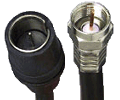 | 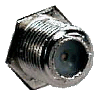 |
| Category 3 Wire: Used as phone wire. Each pair of twisted wires handles 1 phone line. Typical Cat 3 wire contains 2 pairs of wire for 2 phone lines, but the plugs can handle 3 pair for 3 lines. For future proofing (for VOIP - Voice Over Internet Protocol or other technologies), it is best to use Cat5e or better as phone wire and leave the extra conductors unused. Phone wire can be Black, Red, Green, & Yellow, or Orange Stripe, Blue, Blue Stripe, & Orange. | ||
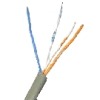 | 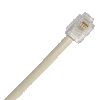 |  |
| Category 5, 5e, 6, & 7 Wire: Used for Internet networks. Your Cable or DSL modem will output this network wire, with Category 5 being the lowest quality and the proposed Category 7 standard the best. All 4 types basically look the same, but the extra twists and better shielding in the higher categories allows for greater amounts of data to be transmitted. This wire can be used for other data applications such as remote volume control knobs, security cameras, infrared (remote control) distribution... | ||
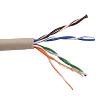 | 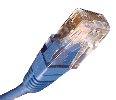 |  |
| Speaker Wire: You need to run speaker wire for in wall/in ceiling speakers. You may also run it in wall so that the wires will not be visible on the floor. Just run the wire from terminals behind your entertainment center to wall plates behind your speakers. It comes in 2 conductor (red & black for + & -) or 4 conductor (red, black, white & green = left+, left-, right+ & right-). 4 conductor wire costs more per foot, but it is cheaper to run 4 conductor wire from the entertainment center to the first speaker and then the second. 16 guage wire is probably adequate for most jobs. An inwall subwoofer might warrant 14 or 12 guage. | ||
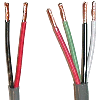 | 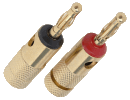 | 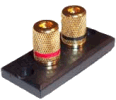 |
| Optical: Optical wire is currently used for digital audio, but in the future it may be used for many other applications like Internet and Television. Some phone companies are starting to wire new neighborhoods with fiber to provide television. Some structured (bundled) cables come with one or 2 fiber optic wires. | ||
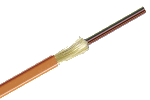 | 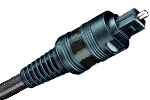 | 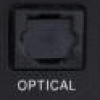 |
| Composite: This cable is used for both audio and video. The video quality is the worst available and cannot handle HDTV signals, but it is still a very popular and inexpensive format used as a base input/output format in almost every device. Each composite cable contains a main conductor and a shield. Coax cable with its good shielding is the best bet for long composite cable runs. | ||
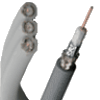 | 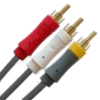 |  |
| BNC: BNC cable is used in many of the same situations as Composite or Component cable. Many times the connector can be converted between BNC and Composite or Component. BNC offers a better quality cable (usually a shielded coax cable) with a quick twist connector that cannot fall out on its own. | ||
 | 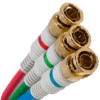 | 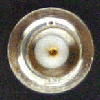 |
| S-Video: This is a popular video format that is quickly being replaced with DVI and HDMI. S-Video cable is actually 2 Coaxial cables in one. There are 2 signal cables (Y & C) and 2 grounds. You can use 2 Coaxial cables instead of specific S-Video cable or even Cat5e cable although the signal wont be as good with Cat5e because of the lack of shielding. | ||
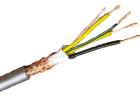 | 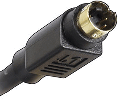 | 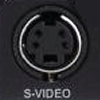 |
| Component: This video format is better than S-Video but is less common and is being replaced by DVI and HDMI in newer flat panel televisions. Just like composite cable, coax cables also make the best component cables. | ||
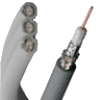 | 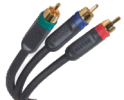 |  |
| VGA (Video Graphics Array): This is the old computer monitor video format which can be found is some old flat panel televisions. Most flat panel computer monitors have now adopted the DVI-D format, leaving the VGA format for CRT tube monitors. | ||
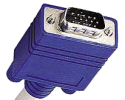 | 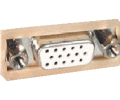 | |
| DVI (Digital Visual Interface): This is the current video format for most flat panel computer monitors and was popular with flat panel televisions before the advent of the HDMI format. DVI comes in 3 formats. In DVI-D (Digital) the wire carries only a digital signal. In DVI-A (Analog) the wire carries only an analog signal. DVI-I (Integrated) cables carry both the digital and analog signals. There are also converters that can convert a DVI digital signal to HDMI or DVI analog to VGA and vice versa. | ||
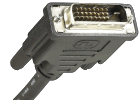 | 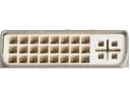 | |
| HDMI (High-Definition Multimedia Interface): This is currently the latest standard for high-end flat panel televisions. It carries both audio and video signals. | ||
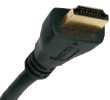 | 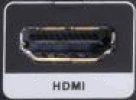 | |
| DisplayPort: DisplayPort is capable of higher higher resolutions compared to HDMI and it also carries both audio and video signals. | ||
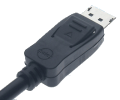 | 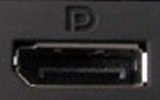 | |
| Infrared: If you will use your remote in one room, and have your stereo components in another room, then you need a Infrared (IR) repeater. The sensor needs to be located in the room that you will use the remote. The main unit and repeaters should all be with the stereo components. IR repeater systems are usually sold as all-in-one kits, although some types let you use your own wiring for longer runs. | ||
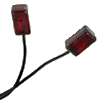 | 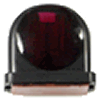 | 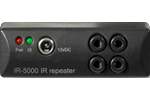 |
Notes:
HDCP (High-bandwidth Digital Content Protection): All video formats DVI and later are compatible with HDCP which is a copy protection scheme to prevent theft of TV/movies. Not all devices support HDCP, and you may have trouble connecting two devices if one supports the protection scheme and one does not. Check with your manufacturer's documentation.Wire Length: Some of the wire types listed above have very short ranges (just a couple of meters) due to their high bandwidth. Some of these specs can be stretched, especially if you are not running the wire at its max bandwidth. For example, VGA, Composite, and S-Video wires are designed to work for a couple of meters, but I have used 50+ foot cables for each.
Cable, Phone, Network, and Speaker wire all allow for very long runs.. The rest of the wire types have limited ranges and should be as short as possible.
For example: Maybe for a home theater system you will hide the components in another room right behind the TV or in the basement right under the TV. This is more common if you hang a flat panel TV on the wall, you have in-wall speakers, and you don't want to see the stereo components. In these cases the wires should only be a couple of meters long and shouldn't cause any problems.
